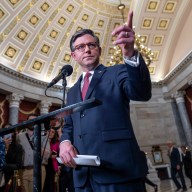The bus lurches to a stop behind a rush-hour fender bender.
Passengers look up from their laptops and BlackBerrys, pausing from answering e-mail or watching YouTube via wireless Internet access.
Their trip home is delayed.
Luckily, the vehicle has a satellite transit tracking system that shows buses and streetcars on nearby lines moving well. The information is available at passengers’ fingertips via on-board touch screens, which provide real-time updates on route delays and connections.
It means riders can hop off and be assured of grabbing another bus and still getting home in time for dinner.
A futuristic glimpse of public transit? No, today in San Francisco.
Called the Connected Bus, it’s a lesson in Customer Service 101.
Restaurateurs and retailers have long known how vital it is to provide service that encourages repeat business. But transit operators are behind schedule when it comes to treating riders like customers.
The hybrid-powered Connected Bus, a pilot project of the San Francisco Municipal Transportation Agency (MUNI) and computer networking giant Cisco Systems, features wireless Internet for all passengers; real-time updates on vehicles throughout the system; and even a “green gauge” offering details on the environmental impact of the bus and the individuals riding it.
“What transit customers want the most is consistent, reliable service,” said Judson True, a spokesperson for MUNI, which launched the one-year trial in February. “But they’re also increasingly looking for amenities that enhance their trip.
“The Connected Bus does that.”
The bus, green and black with a rainforest motif and picture of the planet on the side, exemplifies a new tilt toward customer service among forward-looking transit providers.
With congestion reaching intolerable levels and concern about climate change rising, public transit should hold appeal for most people.
But scan any major road in the GTA on a weekday and you’ll see it jammed with cars driven by people who have concluded that crawling bumper-to-bumper is faster and more convenient than the deadly slow, infrequent, uncomfortable or (often) nonexistent alternative.
It will take more than high-tech gadgets to get them out of their cars. Besides increasing the number and frequency of transit vehicles, there are some decidedly low-tech and inexpensive solutions. For example:
l Post schedules for buses that operate more than 10 minutes apart.
l Place an electronic sign at GO parking entrances that would let riders know if a train is late.
l Ensure transit stops offer shelter, a bench and clean surfaces. Keep snow and ice cleared away.
An Ipsos-Reid study last fall for Metrolinx, the body in charge of developing a comprehensive transportation plan for the Toronto region, found “enormous potential” to attract transit ridership with more frequent service.
A subsequent Metrolinx report concluded what’s needed are more comfortable vehicles, protection from the elements and accurate information. “Collectively, they can have a dramatic impact on customers’ satisfaction with their trip….. and, ultimately, the likelihood that they will choose transit again,” the report states.
But more customer service needn’t mean a first-class experience for those who can afford to pay more and a cattle-car ride for the rest, said George Hazel, an Edinburgh consultant whose ideas have caught the ear of Metrolinx chair Rob MacIsaac.
Hazel cites the example of the choices available to travellers making the 25-kilometre trip from Heathrow Airport into London.
They can take a 45- to 60-minute trip on the Underground for about 4 pounds (about 8 dollars Canadian). Or they can take the Heathrow Connect Train, which, for about 7 pounds ($14), will get them to Paddington Station in 25 minutes.
The fastest trip — only 15 minutes — is via the Heathrow Express, a train that runs more frequently and has two classes. The costlier one provides extra legroom, Wi-Fi and a newspaper, for about 25 pounds ($50). But few riders pay 10 pounds more for first class because the frequency is the same in the cheaper Express Class. Reliability and speed are what matter most, Hazel said.
“If you provide a clean, well-maintained, reliable, frequent service going to places people want to go at times they want to go, would people pay a premium for the extra comfort or segregation? They might,” he said. “But there are examples all over the world where if you get it right you get a complete social mix.”
There are two ways transit planners can expand their market share, according to Hazel: big, bold projects like the Shanghai Transrapid magnetic levitating train, or seamless connectivity through “smartcards” and reliable connections.
A smartcard allows the user to load value onto the card and then use it to travel without cash, tickets or tokens across a variety of transit systems. It can also represent a sales opportunity, with the potential to work like ATM and loyalty cards.
Even before Madrid began to massively expand its subway system, use of transit surged with the launch of a smartcard.
That’s a route Metrolinx is pilot-testing with its Presto card, though even this relatively simple idea — a hit in dozens of cities around the world — won’t be available region-wide for at least two years. TTC chair Adam Giambrone argues that Toronto has long transcended the social-service orientation of some other systems.
“People with millions of dollars use the system, not because they couldn’t afford to drive their Porsche downtown but because they look at the traffic,” he said.
“If I’m getting on at Rosedale and I’m going to go to King, you might have a commute under 15 minutes on the subway, and you’d never have that commute in your car no matter how fancy it is.”
Giambrone cites about 175 transit rides per capita annually in Toronto versus about 40 in Mississauga, as proof of the TTC’s reach.
Some upcoming innovations are designed to push that statistic even higher. This month, the TTC will finally unveil a long-promised new website design, which by July will allow riders to buy a Metropass online.
Later this year, it will introduce a GPS-based next-bus-arrival information system that will eventually be rolled out at all stops and stations.
Unlike some other systems in the region, it will also tell customers when the bus is delayed and why.
Next year, passengers will be able to purchase fares using debit cards at machines in more stations, plan their route online and get email alerts about service changes.
While he’s eager to see the electronic innovations in place, Giambrone said they’re only good to the extent that they give riders choices.
“Customer service is about getting accurate information that lets you make a decision: Should I walk? Should I walk back to the station and try and get another bus?”
















